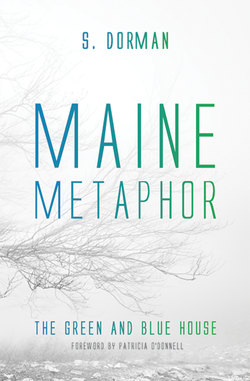Читать книгу Maine Metaphor: The Green and Blue House - S. Dorman - Страница 11
Measuring My Moose
ОглавлениеGood, good, good. A little present to liven up my day and give me something refreshing to puzzle over on my mid-morning’s walk to the post office. Look at that cloven heart shape in the sand shoulder. I splayed my fingers across it. Definitely moose. No self-respecting dainty deer would wear a foot that size. I’d never seen moose tracks on my way to the post office before living in Maine. I’m virtually certain I never saw them in, say, Cleveland, Ohio or Erie, PA.
Walking beside those homely tracks I began to feel like a companion to the moose, who must have passed the night before. I pictured him clomping along in the dark on his way to . . . Here was a moose walking along the pond road, quietly humming some old country and western tune. Probably one with a Marty Robbins flavor. I was shadowing him, wondering where in the heck mooses go at 1 AM. When Thoreau came to experience Maine more than 150 years ago, the moose he saw made him “think of great frightened rabbits, with their long ears and half-inquisitive, half-frightened looks.” He called them “the true denizens of the forest,” and “moose men, wood eaters,” as the word means. The moose and I were not walking through woods as true denizens would, we were approaching the highway.
Still puzzling out the question of the moose’s destination, I was certain it wasn’t the post office. Ours closes at five. But, oddly, Bob’s Corner Store didn’t seem far-fetched. The tracks disappeared at the highway but reappeared again in the sand on the opposite side. I trailed him past Jordan’s Restaurant, up to the turn-off to the ski mountain. We were approaching Bob’s store. Did a moose wander through here last night? I almost asked Bob, who was upending a can of motor oil under a hood.
. . . Those giant cloven hooves . . . “probably making the animal sure-footed on the uneven ground and slippery moss covered logs of the primitive forest.” Thoreau even measured his moose’s lips: “The upper lip projected two inches beyond the lower for the purpose of browsing on trees.” Of course his moose was dead at the time, having been put in that state by his Indian guide. And the moose wasn’t actually Thoreau’s, but his companion’s. Thoreau didn’t go in for killing moose because it resembled killing pasturing cows.
My interest in moose trails, while not yet a science, was certainly becoming a preoccupation. So it was no wonder when, head bent over some obscure and eroded dent in the sand shoulder, I almost missed what could have been . . . my first moose-in-the-flesh on the homeward walk from the post office.
Peripheral vision comes in handy when browsing for moose. A dark shape, I was certain, had flitted across the road. Butterflies flit, you say, not moose. But remember my state. Here is an abstracted former city-dweller, intent upon would-be evidence of moose, scarcely noticing a big dark shape stirring the brush. Better go investigate. Slowly. I love living on the edge but after all there are bear, coyote, and big cats carousing in woods, all exhibiting beast-like tendencies.
The creature was a dark chocolate brown against the vivid green of the pondside wood. It stopped to regard me over its shoulder. How very strange . . . Who would keep a wild, unkempt pony in the swamp?
“Guess what I’ve just seen?!” This burst forth upon my arrival home. “—A wild ass!”
I’m not so dumb. It took only moments to convince me that what I’d seen was indeed a moose. That moose—young, rackless and possibly female—did much to heighten my moose-obsessed state. The encounter was cited in my conversations and in all my letters. “I have seen a moose along the pond road.”
Still, something was missing. The rack. Those who see a moose and yet live would like a gigantic palmate rack to be part of the telling. Thoreau wrote that the rack of the male rises two feet above the shoulders and can reach a spread of up to six feet! There’d be no mistaking that for a pony. Yet, what would you think if, having lived on orderly city or suburban streets most of your life, you suddenly saw an 8 ft. 900 lb. bull-moose—in full-rack regalia—standing serenely beside Hardesty Park across from Joe’s Burgers?
You would think it was fake, that’s what. (I’m talking as one whose only education in moose has been an excess of Bullwinkle cartoons.) Metropolitan that you are, what would you think if you saw this great splendid eye-opener standing alongside the suburban Valley Parkway? You’d think: That can’t be real—it’s plastic. Further, one can take the metropolitan out of the metropolis and transplant him or her to Maine, but, even after a year, they will still think a bull-moose standing by the wild pine road beneath a glowering mountain is nothing but plastic. A giant Disney™ figurine.
And yet you’ll screech on the brakes for a plastic moose if traffic is sparse.
And the moose will turn about and move. Stun you with his crowned but awkward majesty, even while you sit like a figurine, staring. I watched my bull-moose’s retreating rump without a thought for the tape measure.
Introduce an extra-terrestrial to a woman in blue jeans standing beside a bull-moose crowned with great antlers (as white as bone), ask the extra-terrestrial which of these creatures is a monarch, and . . . .
Well, you know what the answer will be. One is a creature who lives off the harsh landscape and flourishes like a furred king, crowned with palmate rack. The other can hardly distinguish moose tracks from horse-hoof prints.
